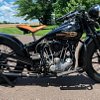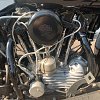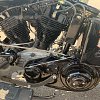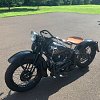An experimental Harley-Davidson is back up for sale on eBay right now for a cool quarter of a million bucks.
As it was never put into production, there’s not really a model letter code I could reference here to describe it, but this motorcycle was Harley’s foray into smaller-than-Big-Twin-production OHV engines, and this one in particular is important because it’s a one-of-one prototype, a bit different from the others among the handful of prototypes created at the same time.

In the days of the flathead, overhead valves were seen as exotic race equipment. Harley-Davidson understood that the flathead had fairly limited potential, due in part to poor heat transfer, poor combustion chamber design, and a tortuous path for the air and fuel mixture to navigate. The V-series motorcycles being produced in the early 1930s were notorious for piston problems due in part to the flathead's tapered bores, used to help mitigate the heat generated by the valves’ location in the jugs.
This story is part of our series called "Stuff that doesn't suck." In the moto world, we all see things that aren't major news, but still stir our emotions and make us stop and say, "You know, that doesn't suck." Whether it's a really neat motorcycle, an inspired customization or an act of kindness or generosity, we want to shine a light on the good stuff in motorcycling. Seen something that doesn't suck? Tell us about it. Send an e-mail to CommonTread@RevZilla.com.
The new steel-strutted pistons that went into this experimental machine were such an improvement over previous unsupported slugs that they were put into the existing flathead models beginning in ‘39. Their reliability helped cement the idea that overhead valves, too, were perfectly acceptable for street work.

Notes from H-D board meetings at the time highlight the fact that there was no definite idea on exactly what to do to move the company forward as the Depression took its toll. Several ideas were suggested, and some prototypes resulted. This motorcycle is one of them, and it is unique in that it’s the only one with a motor constructed entirely of aluminum.
One of these prototypes was built and tested by factory test rider Art Kauper in February of 1939, which is documented thoroughly by Herbert Wagner in "Harley-Davidson 1930-1941." Generally, he was full of praise for the machine. Ultimately, the engine was so good, it strained the transmission, initially developed for the much-less-powerful 45 sidevalve.
Ultimately, of course, Harley halted much of its R&D due to WWII, though there were some notable developments for the military. (Liquid-cooled heads come to mind, as does the XA.) However, in both cases (and most others), longevity was the order of the day, not power. By the time the war was no longer the company’s main preoccupation, staying solvent was not a concern — meeting demand from returning servicemen and commercial customers who had been unable to purchase adequate stocks was.
I think this motorcycle is important because it packages so many technical advances we now take for granted, all in one motorcycle from a time long before many of these benefits rolled out to consumers. Overhead valves, of course, had been seen on the ‘36 EL, and recirculating oil was introduced on the 1937 models, so those weren’t brand-new, but they were still pretty fresh.

But four cams coupled with overhead valves wasn’t seen on a Harley until 1957 with the advent of the Sportster. And an all-aluminum engine (cases, jugs, and heads) didn’t come about until the Evolution in 1984!
Yet here we have all those things in a single machine, a one-of-a-kind factory hot rod.
I’ve been in touch with this seller previously on some really choice items in his collection he’s been selling for a while, but I must say, for this Harleyphile, this is a particularly eye-popping motorcycle.
The motorcycle appeared to have sold in a transaction in early August for an amount significantly lower than the current asking price, but evidently that deal fell through, so the opportunity exists yet again for someone to take possession.
I’m already excited for the new owner.

 Membership
Membership









